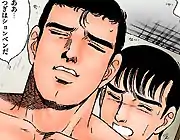Kuso Miso Technique
Kuso Miso Technique (Japanese: くそみそテクニック, Hepburn: Kuso Miso Tekunikku) is a Japanese one-shot bara manga written and illustrated by Junichi Yamakawa. It was first published in 1987 in Bara-Komi, a manga supplement of the gay magazine Barazoku. The short story is a famous meme on the Internet (especially on Japanese Internet forums). It is largely considered the representative work of Yamakawa and responsible for the revived popularity of his manga.[1][2]
| Kuso Miso Technique | |
 Title page of Kuso Miso Technique | |
| くそみそテクニック (Kuso Miso Tekunikku) | |
|---|---|
| Genre | Bara |
| Manga | |
| Written by | Junichi Yamakawa |
| Published by | Daini Shobō |
| Magazine | Bara-Komi |
| Published | 1987 |
Etymology
Some translate the title as meaning "Poop Soup Technique". "Kuso" (くそ) means "crap", though the word is often used simply as interjection. Miso is actually a kind of seasoning used in miso soup.
Kuso Miso figuratively meaning "mess, muddle", a state where one cannot tell the difference between brown miso paste and feces.
Plot
Masaki Michishita, a "typical guy" enrolled in preparatory school, is running to the park washroom when he spots a man wearing a jumpsuit sitting on a nearby bench. The man, Takakazu Abe, unzips his jumpsuit and exposes his penis, asking Masaki, "Shall we do it?" (やらないか, yaranai ka). They proceed to the washroom to have sexual intercourse.
When Abe performs fellatio on Michishita, the latter cannot hold his bladder and accidentally urinates in Abe's mouth. Abe suggests that Michishita empty his bladder in Abe during anal sex, and Michishita does so. When it is Michishita's turn to be on the receiving end, he defecates on Abe's penis, much to the dismay of Abe and the embarrassment of a middle-aged man walking by, who overheard their conversation: "But you never know, it might be fun to do it covered in shit."
Characters
- Masaki Michishita (道下 正樹, Michishita Masaki)
- A prep school student with no prior sexual experience with men, though he often fantasizes about them. He is strongly attracted to Takakazu Abe at first sight, prompting him to think, "Whoa! Hot guy!" (ウホッ! いい男…, Uho! Ii otoko...).
- Takakazu Abe (阿部 高和, Abe Takakazu)
- An auto mechanic. In the story, he sits provocatively on a park bench looking for sex. He is well-endowed and an experienced sexual partner.
Impact

Interest in this manga outside of homoerotica circles sparked more than ten years after its first publication, as it was illegally posted on Ayashii World in 2002. There, the manga gained some interest for its surreal depiction of gay men and its cheesy storyline.
In March 2003, pages of the manga were posted on Futaba Channel, triggering the so-called "Yamajun boom" of interest in Junichi Yamakawa's works.[2] At the same time, Shift_JIS art of the manga produced on 2channel also contributed to the boom. Since then, lines from the manga such as "uho! ii otoko" and "yaranai ka" became known as the "Yamajun language", which became popular Internet slang. On Japanese forums and imageboards, as well as in homosexual circles, the interjection "uho!", along with other lines from his manga, is often taken in a homoerotic context for the above reason.[2] "Yaranaika" itself was ranked the 16th in 2007's "Net Slang of the Year" in Japan.[3] Parody art of the manga, usually achieved by photoshopping the characters' orgasmic expressions onto other images, are often seen at various imageboards. Similarly, Takakazu Abe makes several (unnamed) comic-relief cameos in the hentai manga Alignment You! You!, saying his famous line in most of them. The manga was also referenced in the 2012 anime series Joshiraku.
A theme song ("Yaranaika") has also been attributed to Takakazu Abe, using homoerotic lyrics to the melody of "Balalaika", a song by Morning Musume member Koharu Kusumi. Yuichiro Nagashima, the cosplay kickboxer, once entered the ring in Abe's eponymous jumpsuit with the parody song as background music.[4] The song remains popular on video sites such as Nico Nico Douga, where it has been integrated into one of the site's most popular medleys.
In 2009, in a survey asking its respondents "which manga do you think is the most interesting?" in a pool of 6000, Kuso Miso Technique came at 11th, beating popular manga such as Gin Tama and Case Closed.[5]
Japanese pornography maker Moodyz released a live-action adaptation in 2012, describing it as a collaboration work with Junichi Yamakawa and a "pinnacle of futanari anal". Female porn stars were cast as the characters Takakazu Abe (Reiko Sawamura) and Masaki Michishita (Uta Kohaku), despite the characters referring to themselves as male in the adult video.[6]
In 2014, American manga publishing firm Digital Manga Publishing created an April Fools' joke where they claimed that their pornographic label Project-H would release Kuso Miso Technique in English.[7]
References
- Kidd, Chip; Kolbeins, Graham; Ishii, Anne, eds. (2014). Massive: Gay Erotic Manga and the Men Who Make It (Kindle ed.). Seattle: Fantagraphics Books. p. 277. ISBN 978-1-60699-785-7.
1987: Bara-Komi publishes Junichi Yamakawa's one-shot manga 'Kuso Miso Technique' – a matter of little consequence in 1987, yet the comic will rise to worldwide notoriety in 2002, when bootleg scans go viral on the Japanese message board 2channel.
- ネット人気でホモマンガ復刻…ヤマジュンって誰だ? [The comeback of homo manga popularity on the Internet... who is Yamajun?]. Zakzak (in Japanese). February 9, 2008. Archived from the original on February 9, 2008. Retrieved July 11, 2009.
- こんな言葉も流行りました 07年ネット用語大全. ITmedia News (in Japanese). December 28, 2007. Retrieved July 11, 2009.
- "【DEEP】地上最強のアニヲタ長島☆自演乙、谷川FEG代表の目前でK-1制圧を宣言!". livedoor Sports (in Japanese). December 23, 2008. Archived from the original on February 6, 2009. Retrieved July 11, 2009.
- 今いちばん面白いと思う漫画はコレだ! 6000人アンケートで決定!. getnews.jp (in Japanese). May 6, 2009. Retrieved July 11, 2009.
- くそみそテクニック (in Japanese). Moodyz. August 13, 2012. Retrieved June 10, 2016.
- "Project-H partners with IKDInternational to bring Junichi Yamakawa's manga to North American shores" (PDF). Project-H. April 1, 2014. Retrieved December 21, 2019.
